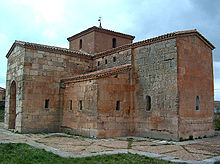San Pedro de la Nave

San Pedro de la Nave ("St. Peter of the Nave") is an
The church, one of the oldest churches in Spain, is of architectural interest and is being considered for World Heritage Site status along with nine other Mozarabic sites. It is currently on a "tentative list" (part of the nominating process).[1]
History
The traditional interpretation is that the church foundation goes back to the reign of

The church's first design corresponded to a
Description
The roof of the church is supported by a barrel vault, but while the vault of the nave and the aisles retains its original stone structure, the western sections of the building are vaulted in brick from the earlier springing points of the ashlar masonry. The arches used are of the horseshoe type (greater than half a circle) of Visigothic architecture. The two arches perpendicular to the axis of the nave spring from impost blocks supported on columns attached to the piers. The arch opening onto the apse is a tighter horseshoe shape resting on two columns in the jambs of the opening.

The decoration of the church is among the most outstanding of pre-Romanesque architecture. There are two types of elements, deriving from different artistic conceptions and different craftsmen: first, a wide frieze corresponding to a course of the ashlar masonry, which shows a successions of circles with various vegetal and animal motives; second, the capitals of the engaged columns. These are of an excellent workmanship superior to that of the frieze. They show biblical scenes such as Daniel in the Lion's Den or The Sacrifice of Abraham. Their abacus blocks are decorated with volutes containing human and animal figures.
There is also a sun-dial inscribed on a stone in the interior wall of the church. The clock was never finished.
Conservation
It was declared a
Originally the church was sited on the banks of the river
See also
Notes
- ^ "Group of Mozarabic buildings on the Iberian Peninsula". Retrieved 2019-06-15.
External links
- Official Blog of the Parish of San Pedro de la Nave
- El Portal del Arte Románico; Visigothic, Mozarabe and Romanesque Art in Spain.
- San Pedro de la Nave webpage (in Spanish)
- The Romanesque in Zamora (in Spanish)
- The Art of medieval Spain, A.D. 500-1200, an exhibition catalog from The Metropolitan Museum of Art Libraries (fully available online as PDF), which contains material on San Pedro de la Nave (p. 15-16)
